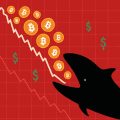Many people are tired of the market’s uncertainty. One moment, we break the $100k mark, and before we can celebrate, a correction happens, and the price drops below $96k. It’s as if bad news are held back for such moments to prevent the price from shooting up. However, no matter what, the first cryptocurrency may still respond slightly to such news – but in the global trend, Bitcoin is rising.
There are several different thoughts on what’s happening, so let’s take a look at them.
Indian expert Omkar Godbole predicts a price drop to $75,000 per coin. He argues this based on the “head and shoulders” pattern and expects confirmation if the price of the first cryptocurrency drops to $92,000.
Patterns don’t always play out, and it’s important to consider the strength of buyers and the news backdrop.
Another expert, Arthur Hayes, has a more bullish outlook and believes the end of the bull market will come in mid-March.
In his new essay, former BitMEX CEO Arthur Hayes expressed confidence that the market will reach its peak in mid-March. According to Hayes, now is the right time to take on more risk in the market. However, to avoid missing out, it’s better to lock in profits before April. Taxes and tightening liquidity might trigger a correction.
Hayes explains his forecast by citing macroeconomic factors, especially the strong dollar. With the reduction of RRP balances and TGA spending, liquidity will rise by $612 billion.
RRP is a tool of the US Federal Reserve that allows the central bank to attract short-term money from financial markets.
There are also other patterns that have worked like clockwork year after year. One of them is the upcoming Chinese New Year, during which the first cryptocurrency rose, and MicroStrategy has been eagerly buying BTC for the 9th week in a row, adding more than 1000 coins to its balance (although, let’s say, such a large stake in a single asset is already a cause for concern!).
No matter what, there are many predictions and scenarios, so our task is to keep a cool head, stick to our principles, follow gradual investment rules, and gradually take profits when appropriate.




